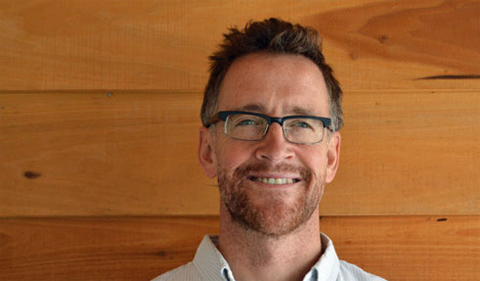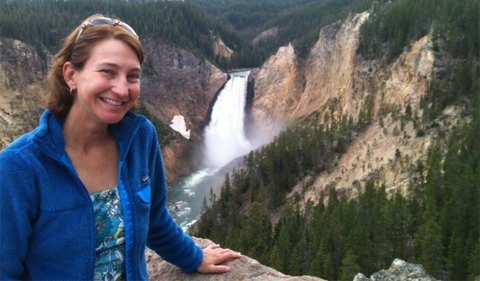Dr. Geoff Buckley, Professor of Geography, has co-edited a new volume of essays, The American Environment Revisited: Environmental Historical Geographies of the United States (Rowman & Littlefield).
Buckley’s co-editor, Dr. Yolonda Youngs, is an assistant professor of global studies at Idaho State University.
“Because I am an environmental historical geographer, my research focuses on how the past informs the present,” Buckley remarks. “This book really encapsulates what I do and what I’m interested in.”
Building Upon a Mentor’s Work
Together, they endeavored to build upon the 1992 landmark text, The American Environment: Interpretations of Past Geographies (ed. Lary M. Dilsaver and Craig E. Colten). Buckley and Youngs note that this volume was foundational in developing their own scholarly interests and areas of research.
 Dilsaver and Colten originally planned to co-edit an updated volume that built upon their 1992 work, but at the 2014 World Conference on Environmental History in Portugal, Colten handed the reins to Buckley and Youngs.
Dilsaver and Colten originally planned to co-edit an updated volume that built upon their 1992 work, but at the 2014 World Conference on Environmental History in Portugal, Colten handed the reins to Buckley and Youngs.
“We wanted to pay homage and commemorate the 1992 volume, but we also wanted to show where the field has gone since then,” Youngs states.
Where the field has gone, she explains, can be summarized in four parts: 1) the expansion of the field, 2) the increase in practitioners, including women, 3) the shift in methods and technology employed, and 4) the diffusion of new methodologies and critical approaches.
Youngs explains that geographers have been studying the environment through a historical lens for many decades, and that this approach informs the entire collection.
“Yolonda and I decided that it would be great to provide, 25 years on, an update on environmental challenges and environmental historical geographers’ thoughts on how to mediate those challenges,” Buckley explains.
Because Colten served as Buckley’s mentor during graduate school, this project holds special meaning.
“Craig was a key mentor for my work in environmental history and historical geography. He was extremely helpful and even vetted my first couple of articles,” Buckley states.
White-tailed Deer, Kudzu, and 9/11: A Broad Range of Topics
“A lot of these chapters focus on the role humans have played in manipulating the changing environment, as well as the ways that the physical environment responds,” Buckley says. It is important, he adds, to study past human behavior, legislation, and environmental upheavals in order to understand the present landscape.
The volume achieves this goal by examining a diverse array of topics. It features five sections:
- “Nature Gone Wild”
- “‘Parks and Recreation”
- “Living in the City”
- “Transforming the Environment”
- “Eye on Nature”
Topics addressed in the volume include the spread of invasive species, the gendered history of pesticide advertisements, the usefulness of GoPro and other technological advances, environmental and social justice, hydraulic mining, the racialized history of state parks and Jim Crow laws, and several other timely subjects.
Several chapters interrogate human interference with the environment. Included in this category is Bob Wilson’s chapter, in which he examines the population explosion of white-tailed deer in the American Northeast—a result of humans’ elimination of deer’s natural predators.
The deliberate introduction of kudzu for the purposes of soil stabilization, an ultimately harmful decision that Buckley describes as “a self-inflicted wound,” is the subject of Derek H. Alderman’s chapter.
Martin V. Melosi’s chapter, “Fresh Kills Landfill: Landscape to Wastescape to Ecoscape,” examines the “the largest landfill in the world,” a space that eventually became a repository for remains and debris from the Sept. 11, 2001, terror attacks.
Youngs draws special attention to the volume’s final section, which describes innovative ways of seeing the environment. These include paintings and the use of GoPro cameras.
“This is truly a remarkable, amazing section of the book,” she remarks.
Buckley and Youngs began soliciting chapters for the volume in December 2014. Each of the volume’s contributors specializes in an aspect of geography and/or history; all are, as Buckley notes, “at the top of their academic game.”
“Everyone was very enthusiastic about contributing their research to the volume,” Buckley remarks.
‘We Want to Reach Students and Colleagues’
Because the volume considers such a broad range of subjects, there is, Buckley says, “a chapter for everyone.”
Indeed, both undergraduate and graduate students who have an interest in environmental issues are a primary audience for this book. Youngs explains that the book is ideal for adoption in upper-division courses and graduate seminars on geography, public land usage, and similar subjects.
“We want to reach both students and colleagues,” Buckley states, “but because of the diversity of topics and the accessibility of the chapters, we’re hopeful that the general public will find the book interesting, as well.”
Buckley’s Examination of Maryland’s Forestry
In his chapter, “Progressive Legacy: Fred Besley and the Rise of Professional Forestry in Maryland,” Buckley considers the far-reaching influence of Maryland’s first professionally trained forester. Fred Besley, Buckley explains, held his politically appointed position with the state of Maryland for a remarkable 36 years.
Buckley uses a biographical lens to interrogate the ways in which Besley’s work affected, improved, and ultimately preserved a large swath of the state’s landscape. The chapter also explains that Besley’s ideas and policies have been adopted in other states.
“When Besley retired,” Buckley explains, “he continued to practice forestry by purchasing land within the state.” Eventually, after having been responsible for over 100,00 acres of state land, Besley became the largest private owner of forestland.
“He planted a large amount of loblolly pine and restored a great deal of forestland. Today, that is probably some of the most valuable private land in the state. In fact, the State of Maryland recently purchased some of that land from the Besley family,” Buckley notes.
Ultimately, the chapter suggests that Besley’s work 100 years ago can help us navigate and address current challenges, including, Buckley notes, “climate change, rapid development, and urban sprawl.”
“Besley’s fingerprints are all over the state land of Maryland,” he remarks. “Besley tried to instill a sense of responsibility and to suggest that private landowners should buy and restore the land with the future in mind.”
Youngs’s Interrogation of Risk Management in Parklands
Youngs’s chapter, “Wild, Unpredictable, and Dangerous: A Historical Geography of Hazards and Risks in U.S. National Parks,” approaches the subject of environmental historical geography by considering the dangers people encounter in national parks—and how to mediate those dangers.
In keeping with the volume’s historical lens, Youngs considers the formidable record of risks people take when visiting these parks.
“Looking to the past,” she notes, “we need to consider how people interacted with nature and how risks were managed in parks. Essentially, my chapter shows that this is not a new problem.”
Her chapter explores the ways in which visitors to national parks and even the park services employees themselves have engaged in and navigated dangerous situations.
She describes the droves of tourists to Yellowstone National Park, for example, who, from 1931-1942, attended “bear shows” that allowed tourists to watch bears eating garbage. She also highlights the well-known photograph of Yellowstone National Park Superintendent Horace Albright, which depicts Albright seated at a picnic table among three bear cubs.
“From feeding bears to mitigating the dangers surrounding bears, this simply wasn’t a sustainable or safe way for bears and humans to interact,” Young states.
Her chapter is the culmination of 10 years of research, during which she visited 122 park units. Youngs explains an increasing number of people are ignoring posted warnings that attempt to keep visitors safe. When people need to be rescued, she explains, park service’s staff members are thus put in danger.
“Where does the role of accountability lie in those cases?” she asks.
“Kernels of Hope”
Buckley and Youngs note that the volume gives an overview of the remarkable growth that has occurred in the field of environmental historical geography, especially in the past 25 years.
Buckley emphasizes that the book will ideally both inform and encourage its readers.
“I hope that readers will not only understand the role humans have played in modifying the environment, but that they will also find kernels of hope for the future.”




















Comments